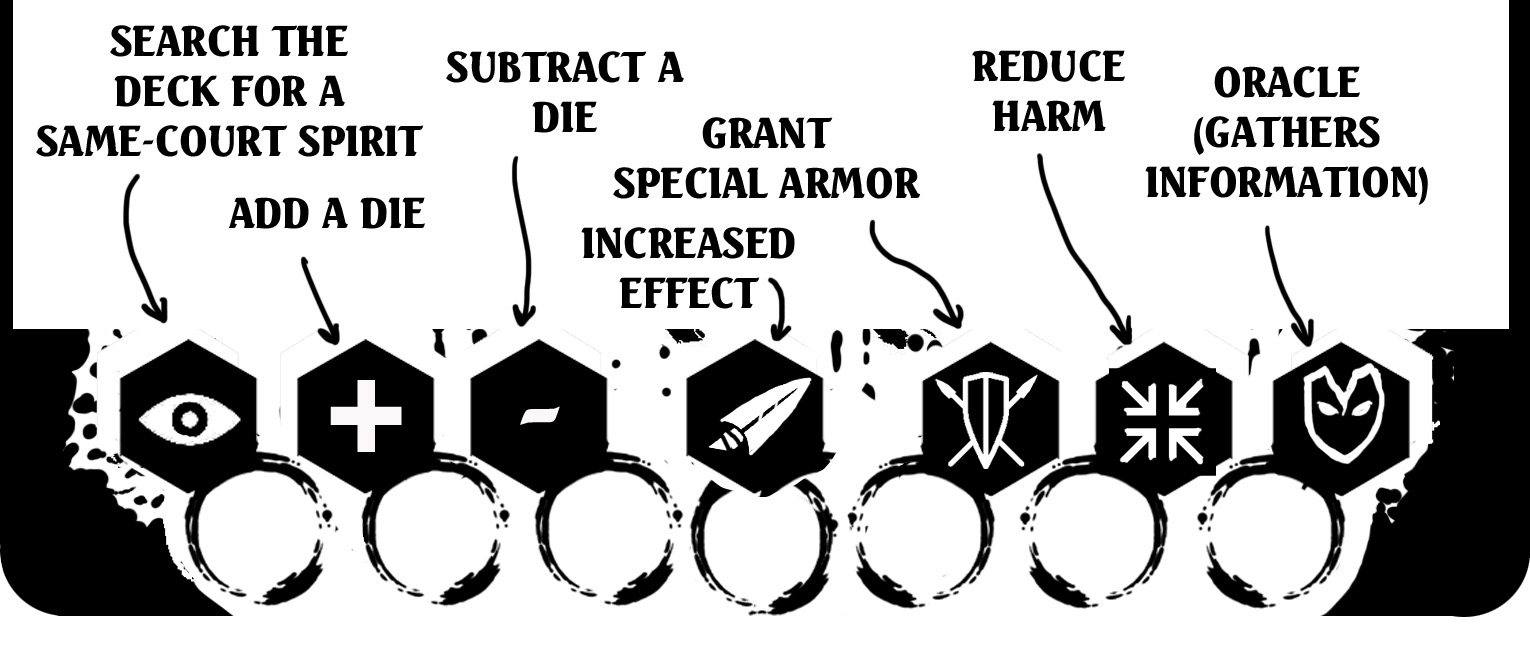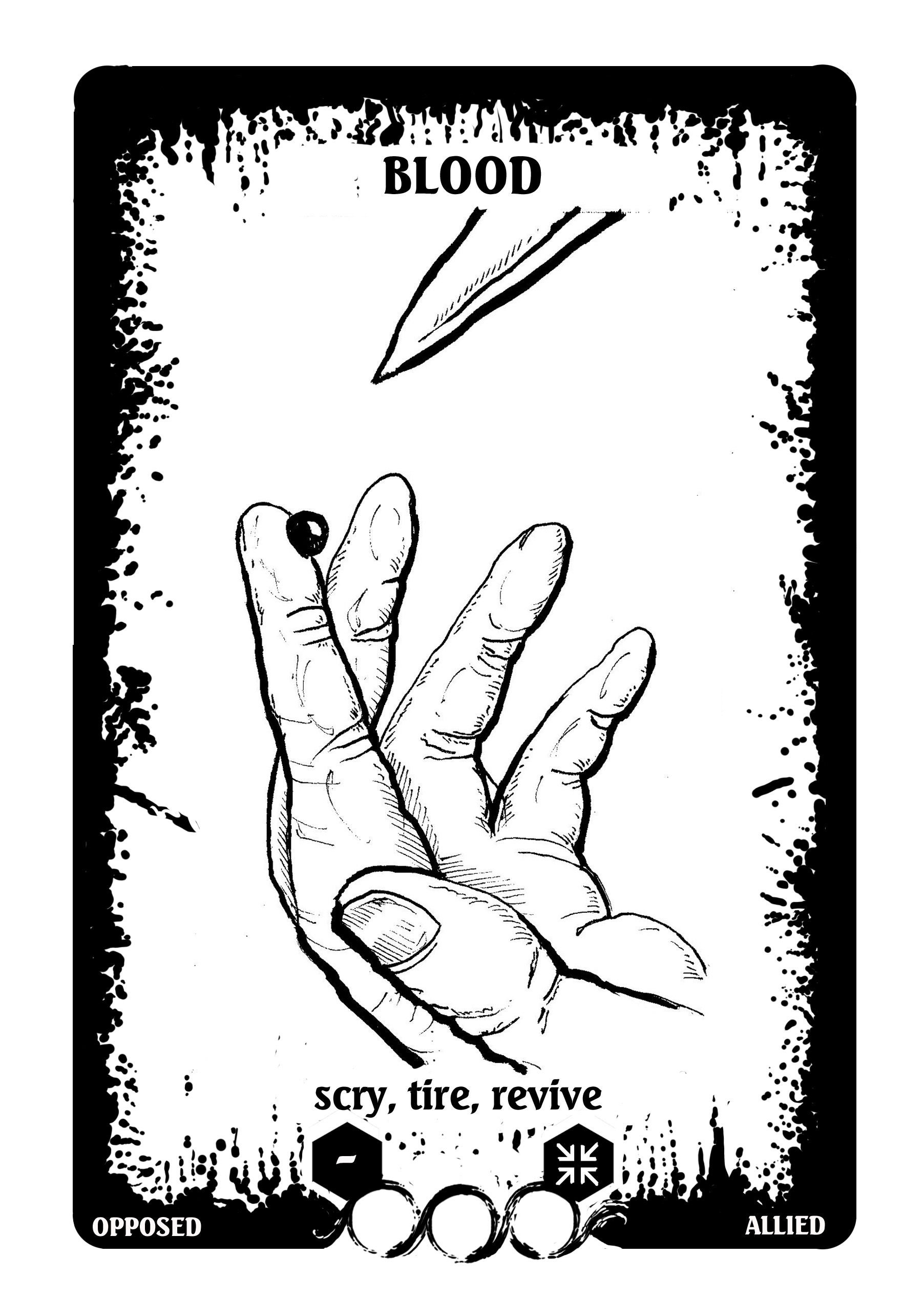Hacking Blades for a more Mythic Approach: pt.4
(Looks like G+ ate my playbook? Maybe the image was too big..)
In practice I’ve found that having a deck of Spirit Cards is great, they serve as useful NPC’s, factions, and “power-ups” for rolls. In different games the spirit of Blood here has been the red glow of healing magic, an infusion to a “hundred bone needle” attack and, my favorite, a sticky little six-inch homunculii who guided the party out of an underground maze with gestures and little grunts and shouts.
In Blades, so much of the results of a roll are neatly spelled out in the scale and effect sections, how to give each Spirit its own portfolio of abilities to make them interesting without disrupting that neat package?
The current solution is to have a selection of icons for the most obvious benefits (key included.)
In play, the PC making a roll may select a spirit from the sideboard instead of taking a Devil’s Bargain and apply the Spirit’s Effect (reduced Harm in the case of Blood) the Spirit will be willing if the humans have its Alliance, require a price if Neutral and may be an active opponent under the GM’s control if Hostile.
In the current version I leave it to the GM and players to work out project clocks for Spirit Diplomacy, some might prefer to have all of Water or Air ally at once, others might want projects for every Spirit.
More complicated Spirits would have full plus/minus three faction meters, Blood is a more simple Spirit, only capable of one degree of alliance/opposition away from neutral.
How does this version look to you all?



Someone needs to design a bot that gives good design feedback.
I dig the icons, clear and easy to remember/interpret. Also I am currently on a cards-to-aid-rpg kick, so I look forward to more stuff!
I think I like the different effects from allied/opposed status. It seems like “subtract a die” is the only detrimental effect. Is that so? Would more complex spirits have multiple effects for various degrees of alliance or opposition (for instance, if Blood had a second level of allied, it might also grant increased effect if allied to that degree)?
I still like the image and phrases for purely inspiration purposes. I will say I wasn’t immediately noticing that the center circle indicated neutral.
Hey Galen, first of all: I really do like the look and the ideas! I am convinced, you’ll find a good solution in the end!
But I’m not sure, if I understand “In play, the PC making a roll may select a spirit from the sideboard instead of taking a Devil’s Bargain” correctly.
One player wants an extry die. And instead of taking the Devils Bargain, he/she can choose – activly – a card? Or are the cards drawn from a stack? Activly choosing a spirit will lead to a double-bonus, I think. Who would ever choose an opposed spirit? Where would be the disadvantage?
In my opinion drawing the spirit without knowing which will come up, adds a little pepper 😉 The players deal with spirits and that’s no exact science… outcomes may vary 🙂
Adam Minnie Good question, a simple Spirit should only be able to apply its one power for good or ill, right? A more complex Spirit, like the Queen of the Sea could have her own clock that starts up as she begins machinations against the players’ Village, sending tsunamis and colossal sea monsters… A change of shape should fix the neutral circle issue.
Skasi Ah, thank you. I was unclear.
Currently I have the players beginning each Journey (the Atoll version of a Heist) with a selection of (number of players plus 3) Spirits randomly drawn and laid out where everyone can see them. These are the Spirits that the Heroes begin with an easy connection to.
Friendly & Neutral Spirits are good for Devil’s Bargains. Hostile Spirits are storm clouds on the horizon. Bad actors that will possibly show up to interfere with the deeds of the Heroes.
If the Heroes happen to bring a new Spirit into play through, well, play, then the GM can just search for it and add it to the play area.
For example, in one session, the Sorcerer was trying to speak to the shredded remnants of a villager looking for guidance, and that Blood homunculii mentioned earlier grew organically out of the interplay between GM and player.
Ooooh, you could treat the drawing of the spirits like a tarot spread, so their positions have meaning (whether purely narrative or also mechanically significant).
Why are you scaling the number of spirits with the number of players?
I really love the grungy/used style of the cards. Well done!
Benjamin Davis’s tarot positioning idea made me think of significance to whether they are right side up or upside down. Maybe allied status and effects are noted on one side (right side up) and opposed status and effects are noted on the other side (upside down)
Now my head is spinning with the idea of spirits that appear in multiple aspects, based on whether they come out upright or inverted.
And game effects that let you spin them, or, in the longer term, cut and spin half the deck.
Benjamin Davis A limited number of available Spirits at the beginning focuses the players’ minds, gets them thinking creatively about how to use the cards in front of them rather than always going for old reliable. Certainly more spirits can enter the field as play requires.
Oh, I certainly think limiting the available spirits is necessary, I just mean why scale the available number with the number of players? Why not just start with a fixed number?
Benjamin Davis That’s a GM habit I fell into some years ago, likely from Savage Worlds. Blades certainly doesn’t need enemies to be scaled or level-balanced for encounters, but player resources such as Spirits seem to benefit from scaling up and down. In a four hour session I’ve found that players use about 1-2 Spirits, so I try to provide that.